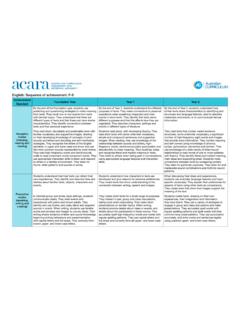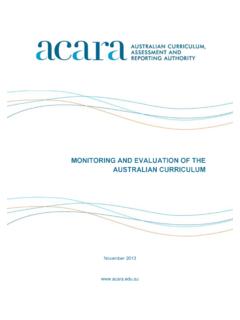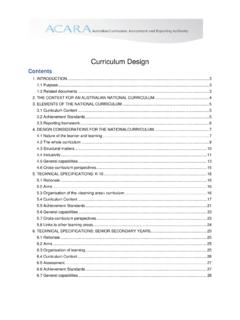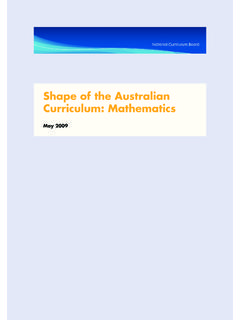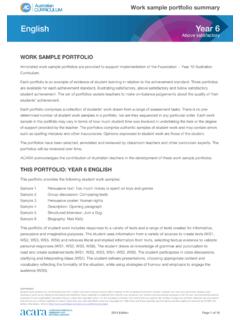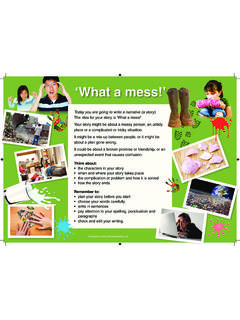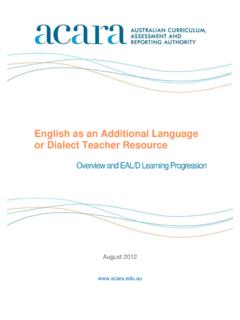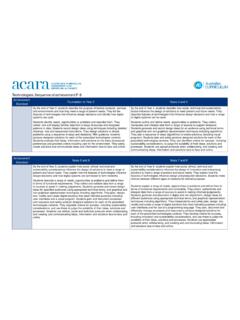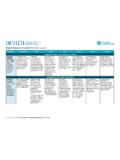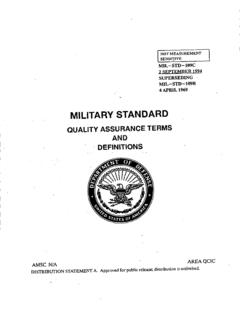Transcription of nglish Year 2 - ACARA
1 EnglishYear 2 Below satisfactory2014 EditionPage 1 of 14 Work sample portfolio summaryWORK SAMPLE PORTFOLIOA nnotated work sample portfolios are provided to support implementation of the Foundation year 10 Australian portfolio is an example of evidence of student learning in relation to the achievement standard. Three portfolios are available for each achievement standard, illustrating satisfactory, above satisfactory and below satisfactory student achievement. The set of portfolios assists teachers to make on-balance judgements about the quality of their students portfolio comprises a collection of students work drawn from a range of assessment tasks. There is no pre-determined number of student work samples in a portfolio, nor are they sequenced in any particular order. Each work sample in the portfolio may vary in terms of how much student time was involved in undertaking the task or the degree of support provided by the teacher.
2 The portfolios comprise authentic samples of student work and may contain errors such as spelling mistakes and other inaccuracies. Opinions expressed in student work are those of the portfolios have been selected, annotated and reviewed by classroom teachers and other curriculum experts. The portfolios will be reviewed over time. ACARA acknowledges the contribution of Australian teachers in the development of these work sample portfolios. THIS PORTFOLIO: year 2 ENGLISHThis portfolio provides the following student work samples: Sample 1 Text connection: The Deep Sample 2 Narrative text: Cat and rabbit Sample 3 Reading aloud: Amy s Song Sample 4 Written report: Excursion to Kings Park Sample 5 Digital presentation: Emus Sample 6 Descriptive poem: MixturesThis portfolio of student work includes responses to a variety of texts and the development of a range of written and oral texts. The student uses a variety of text processing strategies to read (WS3), retrieve literal information (WS1, WS5), make inferences and find the main idea in a text (WS1).
3 The student creates written and multimodal texts for specific purposes and audiences (WS2, WS4, WS5, WS6), drawing on knowledge of grammar, vocabulary and punctuation (WS2, WS4, WS5, WS6). The student creates texts exploring sound and word patterns (WS6). The student attempts to spell high-frequency sight words and to use sound-letter knowledge to spell new words (WS1, WS2, WS4, WS5).COPYRIGHTS tudent work samples are not licensed under the creative commons license used for other material on the Australian Curriculum website. Instead, you may view, download, display, print, reproduce (such as by making photocopies) and distribute these materials in unaltered form only for your personal, non-commercial educational purposes or for the non-commercial educational purposes of your organisation, provided that you retain this copyright notice. For the avoidance of doubt, this means that you cannot edit, modify or adapt any of these materials and you cannot sub-license any of these materials to others.
4 Apart from any uses permitted under the Copyright Act 1968 (Cth), and those explicitly granted above, all other rights are reserved by ACARA . For further information, refer to ( ).EnglishYear 2 Below satisfactoryWork sample 12014 EditionPage 2 of 14 Text connection: The DeepYear 2 English achievement standardThe parts of the achievement standard targeted in the assessment task are modes (listening, reading and viewing)By the end of year 2, students understand how similar texts share characteristics by identifying text structures and language features used to describe characters, settings and read texts that contain varied sentence structures, some unfamiliar vocabulary, a significant number of high frequency sight words and images that provide additional information. They monitor meaning and self-correct using context, prior knowledge, punctuation, language and phonic knowledge. They identify literal and implied meaning, main ideas and supporting detail.
5 Students make connections between texts by comparing content. They listen for particular purposes. They listen for and manipulate sound combinations and rhythmic sound modes (speaking, writing and creating)When discussing their ideas and experiences, students use everyday language features and topic-specific vocabulary. They explain their preferences for aspects of texts using other texts as comparisons. They create texts that show how images support the meaning of the create texts, drawing on their own experiences, their imagination and information they have learned. They use a variety of strategies to engage in group and class discussions and make presentations. They accurately spell familiar words and attempt to spell less familiar words and use punctuation accurately. They legibly write unjoined upper- and lower-case of taskAfter reading The Deep by Tim Winton, students were asked to consider how it connected with another text they had read.
6 They were asked to: identify the key ideas in The Deep identify another text that connects with The Deep identify the connections between the two had previous lessons on making connections between texts. They had access to library resources and copies of The Deep to use as they sample 1 EnglishYear 2 Below satisfactory2014 EditionPage 3 of 14 CopyrightStudent work samples are not licensed under the creative commons license used for other material on the Australian Curriculum website. Instead, a more restrictive licence applies. For more information, please see the first page of this set of work samples and the copyright notice on the Australian Curriculum website ( ).AnnotationsNames a familiar text that connects with an aspect of the text heard in questions using sentence fragments, for example, because Alice doesn t .Makes connections between two texts describing literal meanings, for example, Grug learns to read and Alice learns to swim.
7 Spells some frequently used words accurately, for example, because , the and uses knowledge of letters and sounds to attempt to spell words, for example, sked/scared , ha/how .Writes a single sentence summary outlining the main idea of a story heard in class, for example, Alice wasn t scared of the deep .Text connection: The DeepEnglishYear 2 Below satisfactory2014 EditionPage 4 of 14 Narrative text: Cat and rabbitYear 2 English achievement standardThe parts of the achievement standard targeted in the assessment task are modes (listening, reading and viewing)By the end of year 2, students understand how similar texts share characteristics by identifying text structures and language features used to describe characters, settings and read texts that contain varied sentence structures, some unfamiliar vocabulary, a significant number of high frequency sight words and images that provide additional information.
8 They monitor meaning and self-correct using context, prior knowledge, punctuation, language and phonic knowledge. They identify literal and implied meaning, main ideas and supporting detail. Students make connections between texts by comparing content. They listen for particular purposes. They listen for and manipulate sound combinations and rhythmic sound modes (speaking, writing and creating)When discussing their ideas and experiences, students use everyday language features and topic-specific vocabulary. They explain their preferences for aspects of texts using other texts as comparisons. They create texts that show how images support the meaning of the create texts, drawing on their own experiences, their imagination and information they have learned. They use a variety of strategies to engage in group and class discussions and make presentations. They accurately spell familiar words and attempt to spell less familiar words and use punctuation accurately.
9 They legibly write unjoined upper- and lower-case of taskStudents looked at a variety of narrative texts and identified how the following elements were used in some of these texts: starting the story by introducing the characters and setting the problem/s evident how the problem is solved finishing with a lesson to learn/happy were asked to use their knowledge of narrative text structure to write their own narratives. They were given an opening paragraph and sentence starters to use in their sample 2 EnglishYear 2 Below satisfactory2014 EditionPage 5 of 14 CopyrightStudent work samples are not licensed under the creative commons license used for other material on the Australian Curriculum website. Instead, a more restrictive licence applies. For more information, please see the first page of this set of work samples and the copyright notice on the Australian Curriculum website ( ).Work sample 2 AnnotationsCreates a very brief imaginative text with some recognisable structural elements of a narrative, for example, a beginning and a capital letters to signal sentence beginnings, for example, One Uses a familiar setting for a narrative, for example, the park.
10 Spells some irregular words, for example, walked , uses digraphs and sound-letter knowledge to spell regular words, for example, cat , park , morning and to attempt unknown words, for example, where/were , wonted/wanted .Develops cohesion through word associations, for example, park , slide , ball , play .Uses familiar common nouns, for example, cat , rabbit .Uses simple, everyday vocabulary, for example, cat , play , rabbit .Uses a basic image of part of the setting to support the text: Cat and rabbitEnglishYear 2 Below satisfactory2014 EditionPage 6 of 14 Reading aloud: Amy s SongYear 2 English achievement standardThe parts of the achievement standard targeted in the assessment task are modes (listening, reading and viewing)By the end of year 2, students understand how similar texts share characteristics by identifying text structures and language features used to describe characters, settings and read texts that contain varied sentence structures, some unfamiliar vocabulary, a significant number of high frequency sight words and images that provide additional information.
